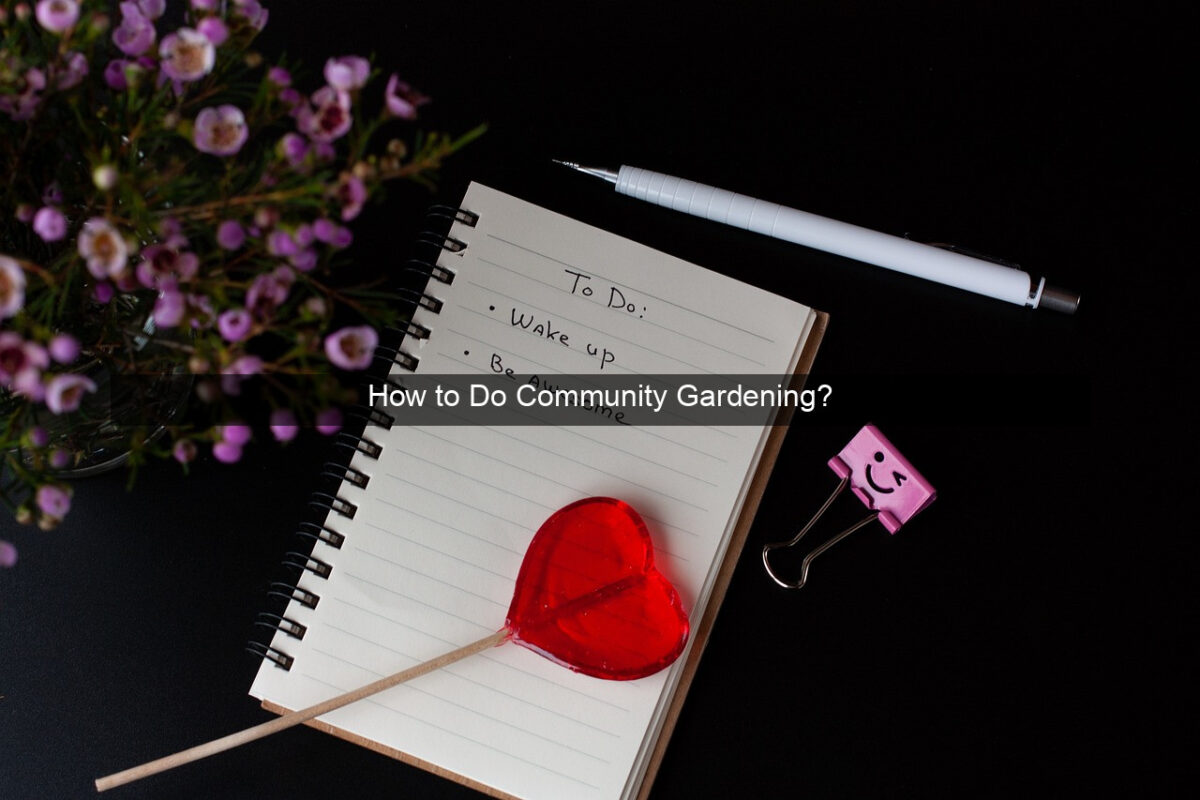How to Do Community Gardening?

- How to Do Community Gardening?
- Digging Deeper: A Guide to Community Gardening
- Finding Your Green Thumb Community
- Locating a Garden
- Joining a Garden
- Preparing for the Growing Season
- Planning Your Plot
- Gathering Supplies
- Nurturing Your Garden
- Planting and Watering
- Weeding and Fertilizing
- Harvesting and Sharing the Bounty
- Enjoying the Fruits of Your Labor
- Conclusion

Digging Deeper: A Guide to Community Gardening

Imagine vibrant green spaces bursting with fresh produce, buzzing with friendly chatter, and fostering a sense of connection within your neighborhood. This is the magic of community gardening! More than just plots of land, community gardens are thriving ecosystems of shared resources, knowledge, and camaraderie. They offer a chance to reconnect with nature, cultivate healthy food, and build lasting relationships. Whether you’re a seasoned gardener or a complete novice, this comprehensive guide will equip you with the tools and knowledge you need to thrive in the rewarding world of community gardening.
From finding the perfect plot to nurturing your first seedlings and celebrating the harvest with your fellow gardeners, we’ll explore every step of the journey. Community gardening isn’t just about growing food; it’s about growing community. It’s about learning from one another, sharing the bounty, and creating a more sustainable and connected world, one seed at a time. Let’s delve into the practicalities and joys of this fulfilling endeavor.
Finding Your Green Thumb Community
Locating a Garden
The first step is finding an existing community garden or starting your own. Research local parks and recreation departments, community centers, and online forums for existing gardens. If none exist, consider rallying your neighbors and exploring potential spaces within your community.
Check with local authorities about permits and regulations for starting a new garden. Identifying a suitable location with adequate sunlight, water access, and soil conditions is crucial for success. Consider factors like accessibility, security, and proximity to community members.
Reaching out to experienced community gardeners can provide valuable insights and support during the initial stages. Networking with local organizations and gardening enthusiasts can help you gather resources, share knowledge, and build a strong foundation for your community garden.
Joining a Garden
Once you’ve found a garden that interests you, inquire about membership requirements and procedures. Many community gardens have waiting lists or application processes, so be prepared to provide some basic information about yourself and your gardening experience.
Attend a garden meeting or workday to get a feel for the community and its culture. This is a great opportunity to meet fellow gardeners, learn about the garden’s rules and regulations, and see firsthand how the garden operates.
Ask about plot availability, fees, and any shared responsibilities, such as watering schedules or communal workdays. Understanding the garden’s expectations and commitments will help you determine if it’s the right fit for you.
Preparing for the Growing Season
Planning Your Plot
Before you start planting, take time to plan your plot layout. Consider the sunlight requirements, mature size, and companion planting needs of your chosen crops. Sketching a diagram can help you visualize the arrangement and maximize space utilization.
Research the best planting times for your region and choose varieties that are well-suited to your local climate. Select a mix of vegetables, herbs, and flowers to create a diverse and thriving garden ecosystem.
Consider using raised beds or other gardening techniques to improve soil drainage and accessibility. This can be especially beneficial in areas with poor soil conditions or limited mobility.
Gathering Supplies
Assemble the necessary tools and materials, such as gardening gloves, trowels, hand rakes, watering cans, and compost bins. Check if the community garden provides shared tools or if you need to bring your own.
Source high-quality seeds or seedlings from reputable suppliers. Consider organic options to promote sustainable gardening practices. Starting seeds indoors can give you a head start on the growing season.
Prepare your soil by amending it with compost, organic matter, or other soil amendments to improve its fertility and structure. Testing your soil can help you determine its pH level and nutrient content.
Nurturing Your Garden
Planting and Watering
Follow recommended planting depths and spacing for each type of plant. Provide adequate water, especially during dry periods, but avoid overwatering, which can lead to root rot.
Mulch around your plants to suppress weeds, retain moisture, and regulate soil temperature. Use organic mulch materials, such as straw, wood chips, or shredded leaves.
Monitor your plants regularly for pests and diseases. Implement organic pest control methods whenever possible to minimize the use of harmful chemicals.
Weeding and Fertilizing
Regularly weed your plot to prevent competition for resources. Hand-weeding is often the most effective method in a community garden setting.
Fertilize your plants as needed to provide essential nutrients. Use organic fertilizers, such as compost tea or manure, to promote healthy growth.
Rotate your crops each year to prevent soil depletion and reduce the risk of pest and disease buildup. This practice also helps maintain soil fertility and improve overall garden health.
Harvesting and Sharing the Bounty
Enjoying the Fruits of Your Labor
Harvest your crops at their peak ripeness for optimal flavor and nutritional value. Share your surplus produce with fellow gardeners, neighbors, or local food banks.
Preserve your harvest by canning, freezing, or drying to enjoy the fruits of your labor throughout the year. Explore different preservation techniques to maximize the shelf life of your produce.
Celebrate the harvest season with community potlucks, gardening workshops, or other social events. This is a great way to build community connections and share the joy of gardening.
Conclusion
Community gardening offers a unique opportunity to connect with nature, cultivate healthy food, and build strong community bonds. By following the steps outlined in this guide, you can embark on a rewarding journey of growth, learning, and shared experiences. Embrace the challenges, celebrate the successes, and savor the fruits of your labor, knowing that you’re contributing to a more sustainable and vibrant community.
What are the benefits of community gardening?
Community gardening provides access to fresh, healthy produce, fosters social connections, promotes environmental stewardship, and enhances community well-being.
How do I find a community garden near me?
Check with local parks and recreation departments, community centers, and online forums for existing community gardens in your area.
What if there are no community gardens in my area?
Consider starting your own community garden by rallying your neighbors and exploring potential spaces within your community.
| Task | Timeframe |
|---|---|
| Find a Garden | 1-2 weeks |
| Plan Your Plot | 2-3 weeks |
| Gather Supplies | 1-2 weeks |
- Gardening Gloves
- Trowel
- Hand Rake





